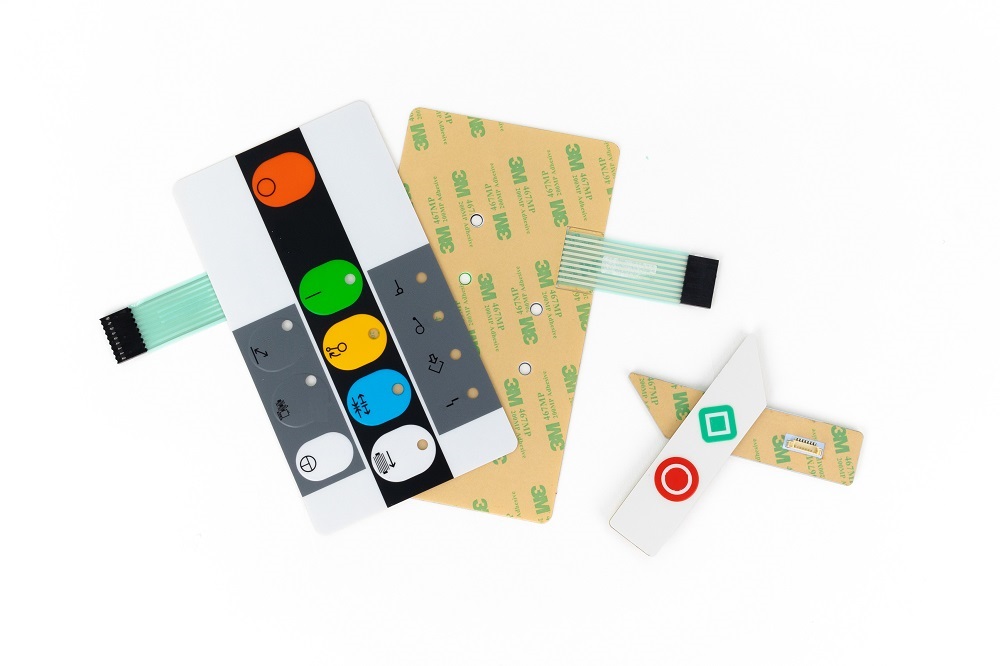Innovative Membrane Switch Solutions for Customized Control Panels
Wiki Article
Understanding Membrane Layer Changes: The Trick to Long Lasting and Reputable Controls

What Are Membrane Layer Buttons?
Membrane layer buttons are a sophisticated service in the realm of interface modern technology, incorporating functionality and design perfectly. These gadgets act as a user interface in between individuals and electronic systems, incorporating a number of parts right into a portable layout. Generally built from versatile, thin layers of products, membrane buttons are made to reply to touch, enabling customers to interact with machinery and electronic tools effectively.The primary components of a membrane layer button consist of a printed circuit layer, graphic overlay, and a spacer layer that avoids unintended activation. The graphic overlay can be tailored to mirror brand name identity or individual preferences, enhancing aesthetic appeals while making sure functionality. Membrane buttons are generally made use of in different applications, including medical tools, customer electronics, and industrial tools, owing to their durability and resistance to environmental variables such as wetness and dust.
Among the vital advantages of membrane buttons is their capability to withstand wear and tear, making them excellent for high-traffic atmospheres. Additionally, they are light-weight and need very little space, permitting ingenious styles in item advancement. Overall, membrane layer changes represent a efficient and practical option for modern digital interfaces, weding technology with user-centric style principles.
Exactly How Membrane Changes Job
The procedure of membrane layer switches hinges on a basic yet reliable mechanism that equates individual input right into digital signals. When a user presses the switch, the leading layer flaws, permitting a conductive element in the circuit layer to make contact with a matching conductive pad on the bottom of the visuals overlay.The layout of membrane layer switches can vary, however they usually incorporate domes or tactile elements to offer comments to the individual, boosting the total experience - membrane switch. The products made use of in membrane layer switches, such as polyester or polycarbonate, add to their resilience and resistance to environmental aspects, consisting of wetness and dirt. The published circuits are typically encapsulated, which protects them from wear and tear over time.
Benefits of Membrane Buttons

Additionally, membrane switches are recognized for their toughness. Created from robust materials, they are resistant to dust, moisture, and physical wear, which substantially prolongs their life-span contrasted to typical mechanical buttons. This longevity makes them especially suitable for high-traffic atmospheres and applications needing durability.
Another significant benefit is the ease of cleaning and upkeep. The smooth surface area of membrane layer switches over lessens dirt build-up and is typically unsusceptible spills, click for info making them suitable for setups that need frequent sanitization.
Moreover, membrane layer buttons use a streamlined profile, leading to a thinner design that can be incorporated right into various devices without including mass. This function not only boosts the visual appeal yet additionally contributes to a more ergonomic item layout.
Applications of Membrane Switches
User-friendly and functional, membrane layer switches locate applications throughout a vast array of markets, including clinical gadgets, customer electronic devices, and industrial tools. In the medical field, these buttons are essential to tools such as diagnostic equipment, individual tracking systems, and mixture pumps, where dependability and convenience of cleaning are critical. Their capacity to stand up to harsh settings and maintain capability makes them optimal for such applications.
In consumer electronics, membrane layer switches are utilized in items like microwaves, washing makers, and push-button controls - membrane switch. Their sleek design enables for intuitive interface, improving the overall user experience while supplying resilience and resistance to tear and put on
Industrial devices likewise gains from membrane layer switches, especially in control panels for equipment and automation systems. These buttons offer protection against dirt and dampness, ensuring consistent efficiency in difficult settings. Furthermore, their customizable functions enable suppliers to customize them to specific operational needs, enhancing efficiency and performance.
Selecting the Right Membrane Layer Change
When choosing a membrane switch, it is vital to think about different elements that influence performance and viability for details applications. The key factors to consider include environmental problems, responsive comments, toughness, and style specifications.
First, assess the operating environment; buttons subjected to wetness, chemicals, or extreme temperature levels need particular materials to make certain long life and performance. Next, review the demand for tactile feedback. Relying on customer interaction, some applications may profit from a responsive reaction to confirm activation, while others might favor a non-tactile style for visual reasons.
Sturdiness is another crucial aspect; membrane layer switches need to be created to stand up to regular use, impacts, and abrasion. Make certain the chosen switch can endure the anticipated lifecycle, especially in high-usage circumstances.

Conclusion
In final thought, membrane layer switches serve as essential components view publisher site in the style of trusted and resilient control systems throughout various industries. The adaptability of membrane layer switches allows for customized remedies useful content that meet particular functional demands, enhancing their significance in contemporary innovation.
Membrane layer switches over stand for a vital element of modern-day interface design, blending performance with strength in numerous applications.Membrane layer switches are a sophisticated service in the realm of customer interface technology, integrating performance and style effortlessly. Generally built from adaptable, thin layers of materials, membrane layer buttons are developed to respond to touch, allowing individuals to connect with equipment and digital tools properly.
The layout of membrane layer buttons can differ, but they often integrate domes or tactile aspects to supply comments to the individual, improving the general experience.In conclusion, membrane switches serve as crucial parts in the layout of durable and reputable control systems throughout various markets.
Report this wiki page